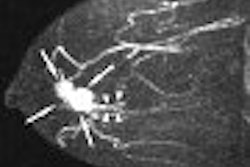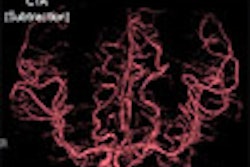Mean attenuation scores at multidetector-row CT show distinct and reliable differences in the composition of atherosclerotic plaques, far surpassing the capabilities of ultrasound, according to a new study from Massachusetts General Hospital (MGH). But on a 16-slice MDCT scanner, overlapping attenuation values still make it difficult to assign specific plaque composition types to specific tissue samples.
Researchers previously showed that lipid-rich and fibrous plaque types could potentially be distinguished at 4-slice CT, and the introduction of 16-slice scanners has brought further improvement, wrote Dr. Maros Ferencik, Dr. Raymond Chan, Dr. Stephan Achenbach and colleagues from MGH in Boston (Radiology, September 2006, Vol. 240:3, pp. 708-716).
The sensitivity and specificity of 16-slice MDCT for plaque detection compared to intravascular ultrasound has been shown to be 75%-82% and 88%-92% respectively. Recently, researchers have sought to distinguish lipid-rich and fibrous plaque on the basis of attenuation.
The MGH team sought to get a clearer idea of 16-slice CT's capabilities by evaluating its performance for the assessment of plaque dimension and composition in both phantoms and ex vivo coronary arteries, with IVUS and optical coherence tomography (OCT) serving as reference standards. Optical coherence tomography is well established for the assessment of plaque composition.
For the current study, molded blood vessel and lesion composition phantoms were built of polyvinyl alcohol hydrogel (60-95 HU at CT) with cylindrical molds to mimic diseased blood vessels with wall thicknesses of 0.7 to 3.0 mm. Artificial "plaques" were fashioned from polyvinyl alcohol fragments, and the contrast agent ioprimide (300 mg iodine per mL) was injected to achieve enhancement of approximately 250 HU. Lucite (approximately 98 HU) was used to mimic fibrous tissue, and cavities filled with lipid concentrations of various compositions.
Another arm of the study examined 18 human coronary arteries. Six left anterior descending, six left circumflex, and six right coronary arteries with plaque but without excessive calcium were excised, rinsed, cut into 5-10 mm lengths, and immobilized in polysaccharide gel before being placed in an anthropomorphic phantom for scanning.
On a Sensation 16 scanner (Siemens Medical Solutions, Malvern, PA) the phantoms and ex vivo specimens were scanned with a cardiac imaging protocol (120 kV, 500 mAs, 0.75-mm section thickness and 0.42-second rotation time). A simulated EKG signal was set to 60 bpm for retrospectively gated construction, which consisted of transverse images at 0.75-mm section thickness, 0.3-mm increments, 12-cm field of view.
Intravascular ultrasound was performed by an experienced investigator using a 40 mHz probe (Atlantis, Boston Scientific, Natick, MA). Optical coherence tomography was performed by the same experienced practitioner, providing in-plane spatial resolution of 10 x 25 mm.
"Mean blood vessel wall areas measured with CT and US in phantoms were 9.2 mm2± 1.8 (standard deviation) and 10.4 mm2 ± 3.4 (bias, -1.3 mm2 ± 3.1; p < 0.05), respectively," the authors wrote. "Mean blood vessel wall areas measured in ex vivo coronary arteries with CT and US were 10.9 mm2 ± 93% and 92%, respectively, for identification of lipid-rich lesions were observed in lesion composition phantoms. Mean CT numbers in blood vessel walls of ex vivo coronary arteries identified at (optical coherence tomography) as predominantly lipid rich, fibrous, and calcified were 29 HU ± 43, 101 HU ± 21, and 135 HU ± 199, respectively (p < 0.001)."
Luminal and cross-sectional measurements were quite similar between US and CT, the group observed, although at gross sectional analysis, CT was found to overestimate these area measurements, the researchers noted.
"Our data from composition phantoms indicate that 16-section multidetector CT can depict lipid-rich lesions (≥ 1.5 mm in diameter ≥ 30% lipid) with a sensitivity of 93% (70/75) and specificity of 92% (23/25)," the team wrote. "In subjects with acute coronary arterial events, typical lipid core dimensions are in the range of 1-5 mm, and more than 80% of plaques have core areas larger than 1.0 mm2. Thus, 16-section multidetector CT has the potential for detection of lesions that cause acute events."
Within the blood vessel wall, however, voxels encompassed a wide range of attenuation values for each vessel cross section and plaque type. "This observation reflects the complexity of atherosclerotic plaques in which lipid-rich, fibrous, and calcified areas coexist and often are intermixed," they wrote. And partial-volume and interpolation artifacts only exacerbate the situation.
Investigators have previously found similarly wide and overlapping CT value ranges in popliteal arteries, making the determination of intraplaque components similarly challenging, they noted.
Because slight differences in the positioning of regions of interest can substantially affect the classification of plaque composition based on CT values, "we suggest that measurements should be performed within the entire region recognized as plaque," they wrote. Composition assessment based on a small region of interest within a given plaque is sensitive to image noise and other artifacts, and this method may also "introduce a bias toward structures that are different from the substantial tissue component of the plaque volume."
Histologic analysis, the reference standard for plaque evaluation, was eliminated in favor of well-validated optical coherence tomography, the authors noted among the study's limitations. Also, heavily calcified plaques could not be evaluated because of blooming artifacts in CT and shadowing in ultrasound. Finally, phantoms can only roughly represent vascular atherosclerosis, they wrote.
At least in the current generation of scanners, assessing the composition of individual plaque is extremely challenging due to overlapping attenuations, they concluded.
By Eric BarnesAuntMinnie.com staff writer
September 18, 2006
Related Reading
MDCT correlates ACS to mixed plaques, April 20, 2006
New cardiovascular CT has high degree of agreement with coronary angiography, February 28, 2006
Multiple reconstructions needed for accurate MDCT calcium scoring, February 14, 2006
MDCT still can't differentiate between noncalcified plaques, January 10, 2006
Copyright © 2006 AuntMinnie.com



















